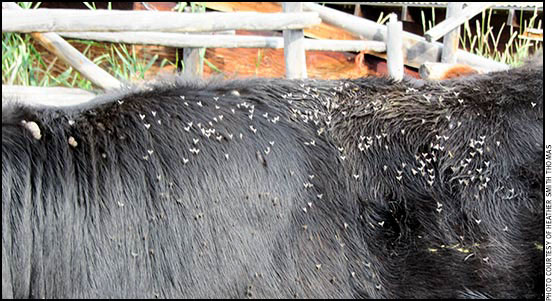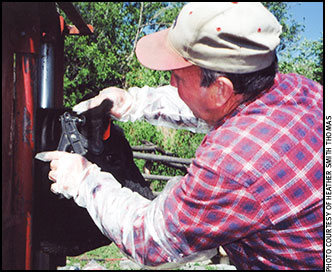
Battling Flies that Bother Beef Cattle
New tools available to combat pests.
The battle against flies is constant during warm weather. Best control is obtained with a combination of tactics. Nancy Hinkle, professor of veterinary entomology at the University of Georgia, says the cattle industry, unfortunately, is very dependent on insecticides. Now we are faced with new generations of flies that have become resistant to these weapons.
We need new methodology, especially for horn flies, she says.
“Across North America, horn flies are still the number one pest. We do have one new ear tag using tolfenpyrad as the insecticide,” she says. “When we tested it, we were impressed because it kept fly numbers below 50 per head for a full two months. The control animals had 200 to 300 flies per animal.”
These are not like pyrethroid tags; they don’t completely wipe out the flies, she says, “but they certainly suppress them. Flies will eventually become resistant; anything we use consistently will lead to resistant flies. But, this gives one more tool, for now.”

One new ear tag using tolfenpyrad has proven effective for two months, keeping flies down to 50 per animal.
There is also a new method for applying insecticide to cattle, with guns that work like a paint gun, shooting a ping-pong-size ball of insecticide, enabling the producer to “shoot” the product onto cattle from a safe distance away.
“We tried this out, too, and my graduate students loved it because it’s fun,” she notes. “I don’t know how it would work on range, but here in the southeast we have pasture cows. It’s easy to walk around or use a 4-wheeler and dose the cattle.”
A person might do the same thing from horseback in range pastures. The rider could target animals with the most horn flies — the ones that are really miserable, like some of the bulls. The gun doesn’t make much noise, and a horse could get used to the sound. If you are out checking cattle anyway, this is something you could take in a saddlebag for horn fly control.
“This is not a new chemical,” says Hinkle. “It’s the same one (lambdacyhalothrin) as the active ingredient in Saber™ pour-on. It is a pyrethroid, so if your flies have already become resistant to pyrethroids, it won’t be very effective. Otherwise, it might help.”
Traditional back rubbers, oilers and dust bags are also helpful in situations where cattle have to go through a gate or learn how to use them in a small area. Cattle enjoy rubbing on these because it gives some relief from horn flies.
“A person has to still go out and recharge the oiler or back rubber,” says Hinkle.
Stable flies can be controlled by cleaning up organic debris where flies breed, like wasted hay around bale feeders, old bedding, etc. Some producers also utilize parasitic wasps in certain situations. These tiny wasps lay their eggs in fly pupae in manure and debris, and the developing wasp eats the fly pupae before they hatch into flies.
A few people are developing lines of cattle that are less attractive to horn flies. With selective breeding a person can utilize those genetically resistant animals and select for that trait along with the other desirable traits in cattle. Most producers are more interested in other traits, however, and fly resistance may be low on their list of priorities.
“This is completely doable, but something a person has to commit to,” says Hinkle. “Today, with more knowledge of genetics, and genetic engineering, we can probably cut down the time it would actually take to produce fly-resistant cattle.”
If producers strategically use several tools and weapons in the war against flies, these pests can be more adequately controlled — and not create resistant flies to have to deal with in the future.
“We are mainly doing the same old things, but trying to suggest different options for control, rotating our insecticides to minimize resistance, etc.,” says Hinkle.
Paying attention to timing, and trying to do the best job with the tools at hand, can be helpful.

Editor’s Note: Heather Smith Thomas is a freelance writer and cattlewoman from Salmon, Idaho.






